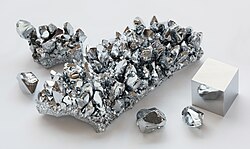Chromium
Chromium oxide was used by the Chinese in the Qin dynasty over 2,000 years ago to coat metal weapons found with the Terracotta Army. Chromium was discovered as an element after it came to the attention of the western world in the red crystalline mineral crocoite (lead(II) chromate), discovered in 1761 and initially used as a pigment. Louis Nicolas Vauquelin first isolated chromium metal from this mineral in 1797. Since Vauquelin's first production of metallic chromium, small amounts of native (free) chromium metal have been discovered in rare minerals, but these are not used commercially. Instead, nearly all chromium is commercially extracted from the single commercially viable ore chromite, which is iron chromium oxide (FeCr2O4). Chromite is also now the chief source of chromium for chromium pigments.
Chromium metal and ferrochromium alloy are commercially produced from chromite by silicothermic or aluminothermic reactions, or by roasting and leaching processes. Chromium metal has proven of high value due to its high corrosion resistance and hardness. A major development was the discovery that steel could be made highly resistant to corrosion and discoloration by adding metallic chromium to form stainless steel. This application, along with chrome plating (electroplating with chromium) currently comprise 85% of the commercial use for the element, with applications for chromium compounds forming the remainder.
Trivalent chromium (Cr(III)) ion is possibly required in trace amounts for sugar and lipid metabolism, although the issue remains in debate. In larger amounts and in different forms, chromium can be toxic and carcinogenic. The most prominent example of toxic chromium is hexavalent chromium (Cr(VI)). Abandoned chromium production sites often require environmental cleanup.
Occurrence
Chromium is the 24th most abundant element in Earth's crust with an average concentration of 100 ppm.Chromium compounds are found in the environment, due to erosion of chromium-containing rocks and can be distributed by volcanic eruptions. The concentrations range in soil is between 1 and 3000 mg/kg, in sea water 5 to 800 µg/liter, and in rivers and lakes 26 µg/liter to 5.2 mg/liter. Chromium is mined as chromite (FeCr2O4) ore. About two-fifths of the chromite ores and concentrates in the world are produced in South Africa, while Kazakhstan, India, Russia, and Turkey are also substantial producers. Untapped chromite deposits are plentiful, but geographically concentrated in Kazakhstan and southern Africa.
Although rare, deposits of native chromium exist. The Udachnaya Pipe in Russia produces samples of the native metal. This mine is a kimberlite pipe, rich in diamonds, and the reducing environment helped produce both elemental chromium and diamond.
The relation between Cr(III) and Cr(VI) strongly depends on pH and oxidative properties of the location, but in most cases, the Cr(III) is the dominating species, although in some areas the ground water can contain up to 39 µg/liter of total chromium of which 30 µg/liter is present as Cr(VI).
| Symbol | Cr | |
| Atomic Number | 24 | |
| Atomic Weight | 51.9961 | |
| Oxidation States | +2,+3,+6 | |
| Electronegativity, Pauling | 1.66 | |
| State at RT | Solid, Metal | |
| Melting Point, K | 2130 | |
| Boiling Point, K | 2945 |
Appearance and Characteristics
Harmful effects:
Chromium metal is an essential trace element, but hexavalent chromium (Cr(VI)) is very toxic and carcinogenic.
Characteristics:
- Chromium is a silver, lustrous, very hard metal that can take a high mirror polish. It is also odorless, tasteless, and malleable.
- The metal forms a thin protective oxide coating in air, and burns when heated to form green chromium oxide(Cr2O3).
Uses of Chromium
- Chromium is used in stainless steel, and other alloys. Chromium plating, for example on cars and bicycles, produces a smooth, silver finish that is highly resistant to corrosion.
- The metal is also widely used as a catalyst.
- Chromium compounds are valued as pigments for their vivid green, yellow, red and orange colors.
